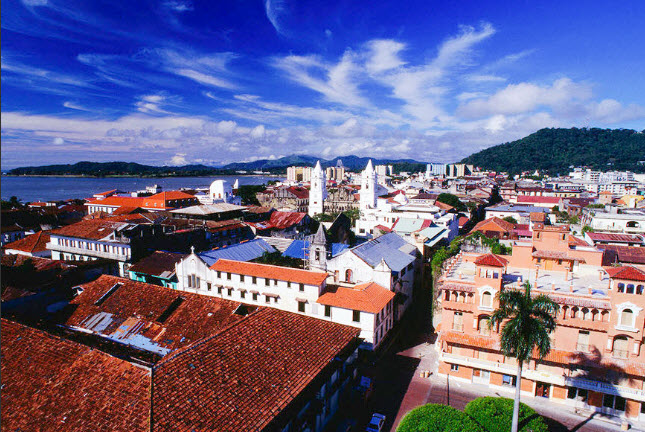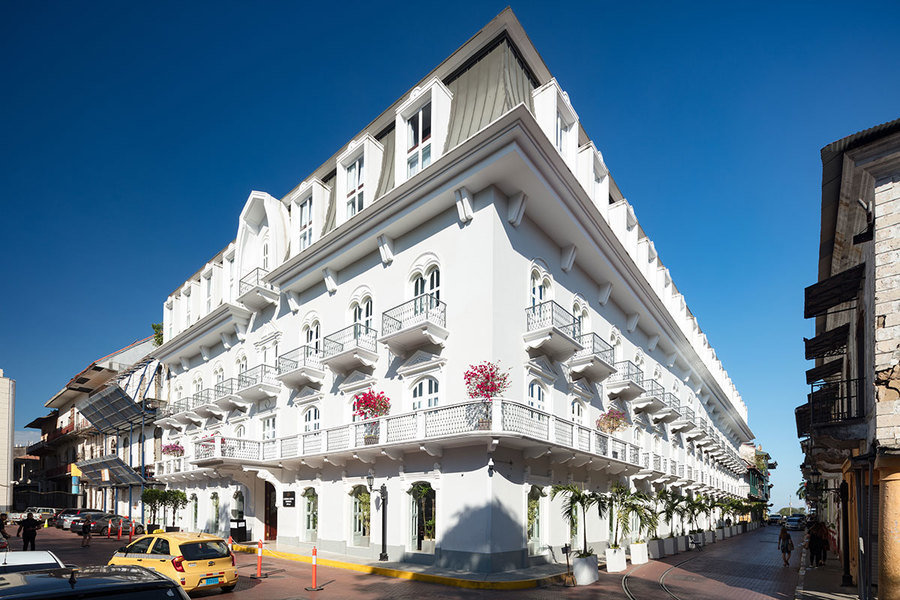Andrea Vaucher writes of her visit in April where she was captivated by Casco. Casco is one of Susie’s and also my favorite places to stay and eat.
For a tiny country, Panama packs a punch.
One sixth the size of California, with about as many people as the city of Los Angeles, Panama is known for its prodigious biodiversity. It’s a global commercial crossroads — 5% of the world’s shipping traffic goes through the Panama Canal — and a natural crossroads as well, a bridge for animal and plant life migration between North and South America. Panama has rainforests, coral reefs, white sand beaches, highland canopies, coastal mangroves and two oceans.
But when I visited in April, I didn’t see ocelots or orchids, butterflies or black umbrella birds.
In fact, I never left Panama City, captivated as I was by Casco Viejo, the old colonial section of town, with its cobblestone streets, renovated/repurposed mansions, and ancient cathedrals, many now romantic ruins.
I was in town for the seventh annual Panama International Film Festival, which meant I would be seeing lots of incredible movies that will probably never make it to Southern California. The festival is open to the public and the screenings are often packed. There were documentaries from Central America — up and down the isthmus — and features from Caribbean island nations. Emerging voices (and personal stories) encouraged by emerging local film industries encouraged by emerging markets. Hola, Netflix!
We stayed at a brand new boutique hotel, the Central Hotel, an elegant whitewashed colonial on a picture perfect square, Independence Plaza. The hotel was the first in the country, built in 1874, even before the French began work on the canal seven years later. It’s been a hotel ever since, though I doubt the original guests would recognize its 21st century amenities like slate and tile bathrooms with deep soaking tubs, a spa and rooftop pool. The top floor rooms have sweeping views of the Bay of Panama or the in-your-face skyline of new Panama City, all soaring modern skyscrapers. The lobby of the Central Hotel soars in its own way. The five-story atrium with its indoor greenery, comfortable couches and a majestic wrap-around staircase in tropical wood, definitely exudes a Graham Greene Caribbean vibe.
Besides Film Festival
activities, which included red carpet premieres and filmmaker talks, we mostly wandered the narrow streets of Casco Viejo, which is a UNESCO World Heritage site and one of the oldest cities in the Western Hemisphere. We sat in outdoor cafes and people watched and drank mojitos in rooftop bars like the Villa Palma. We listened to live music at Grammy-winning Panamanian pianist, Danilo Perez’s jazz club in the American Trade Hotel. The chic property was carved out of what was, just a few years ago, a crumbling ruin of a department store, home to squatters. There’s music everywhere in Casco Viejo. Remember this is the country where another Grammy winner, salsa maestro Ruben Blades, was the Minister of Tourism.
Compared to Costa Rica, which is next door, I found the Panamanian food much more interesting; the chefs here — even at a stand — seemed more at home with spices. I tried to eat as much ceviche as I could. Ceviche with mango. Ceviche with sweet potato. Some of the best ceviche is sold in plastic cups at the Mercado de Mariscos. One afternoon, we grabbed lunch there at an upstairs restaurant, whose modest accoutrements belied its scrumptious cuisine. I devoured a bowl of tiny manila clams in an unforgettable garlicky broth, the aroma of which is still penetrating my dreams.
Of course, we visited the canal. The nearby Miraflores locks are just a cab ride away through the old American Zone. You can see every kind of craft, from private yachts to huge container ships, make their way on the 50-mile journey between the oceans. The ships pass through Miraflores in the morning until around eleven and then later in the afternoon. In the distance, you can see gigantic Neopanamax craft passing through the Cocoli locks, a third newer and larger set, opened in 2016. There’s an interactive museum at Miraflores which gives a concise history of the canal.

Unfortunately, the closest I got to experiencing Panama’s astonishing biodiversity was a visit to the BioMuseo, the Frank Gehry-designed museum, which showcases how the rise of the isthmus of Panama impacted the world ecologically. Even the structure of the museum is said to represent the formation of the isthmus millions of years ago, when two teutonic plates pushed up from the ocean floor, eventually linking North and South America and creating the Atlantic and Pacific Oceans. The building is clearly a Gehry, though very different from his polished steel creations in his use of primary colors. It’s the architect’s only project in Latin America and his design services were a gift to the country in honor of his Panamanian wife, Berta.
On my next visit, I’ll head north from Panama City to the Caribbean coast and explore the San Blas archipelago of islands, home to the indigenous Guna people and an ecotourism hotspot. Near the Costa Rica border, there are the beaches of Bocas del Toro. And the national parks which protect a third of the country are chock full of wildlife, including great bird watching opportunities.
Panama is foreign, but not too foreign, far away but not too far away. It’s an exotic vacation destination devoid of inconveniences like changing money (the dollar is accepted everywhere) and not being understood. With so many Americans around for years tied to the canal, English is spoken widely. And COPA airlines reasonable business class fares for non-stop service between L.A. and Panama City make it an easy adventure indeed.

